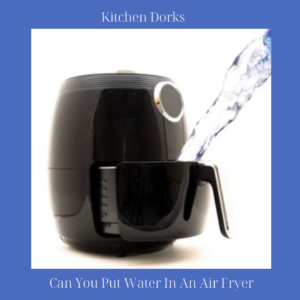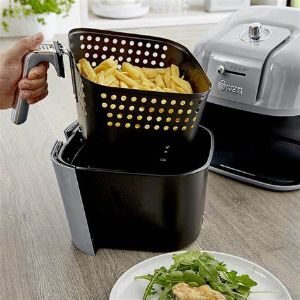
But what if you want to cook something that needs to be submerged in water? Is it possible to put water in an air fryer?
The short answer is Yes and No.
The longer answer is that you can put water in an air fryer, but the results aren’t always good.
We suggest you refrain from putting water in the air fryer.
It uses hot air to circulate food when you cook with your air fryer. The hot air passes through the basket of food and cooks it. This process can take anywhere from 3 to 30 minutes, depending on what you’re cooking, but it doesn’t require any oil.
This means that if you put water in your air fryer, it won’t heat up properly because there isn’t enough heat from the heating element (or lack thereof). When this happens, the food won’t cook evenly, meaning some parts may be overcooked while others are undercooked or raw!
But if you want to add water to your air fryer, we provide you with an ultimate guide.
Many people prefer adding water due to some misperceptions about air fryers, such as do air fryers cause cancer.
If You Want To Add Water Follow These Steps
While it’s not recommended, there are ways to add liquids like water and broth into your air fryer, making it handy for cooking things like fish and chicken breasts.
- If you want to add liquid to your air fryer, there are a few ways to do it.
- You can add 1/4 cup of water or broth to the food or add 2 tablespoons of liquid oil (such as olive or avocado oil) with 1/4 cup of water to the bottom of your air fryer basket before adding your food.
- You don’t want too much liquid because it will only allow enough heat to circulate the food. If you need more than that amount for flavor, add more spices and herbs!
So, How Do You Add Liquid To An Air Fryer?
- Place your food into the basket or tray with your particular model.
- The next step is to add the liquid of your choice (water, broth, or wine) to the bottom of the air fryer.
- You can also use this method if you need more moisture during the cooking time — adding liquid will help keep things moist as they cook.
- The last step is adding any seasoning or spices that you want your food to have before locking down the lid and starting up the machine!
Do’s And Dont’s
While many users say that this method works well for cooking certain foods like fish and chicken breasts, there are some things that you want to keep in mind when doing so:
- Make sure that your particular model allows for water to be added. For example, the Philips Air Fryer has a water tray that can be used for steaming.
- Remember that if you’re using your air fryer to steam vegetables or other foods, you’ll need to preheat it with oil first.
- This is because the hot air will evaporate any moisture from the food before it reaches a temperature high enough to cook it.
- Be careful to fill the basket with water sparingly. If too much water is added, it may splash out of the container while cooking.
- Don’t add any other ingredients or flavorings to the container. This can cause your food to burn if left unattended.
- Don’t use boiling water. This will cause steam and moisture to build up inside your air fryer, which can damage it over time. You should also avoid using cold water or ice cubes (which could cause burns). Instead, use warm water below a simmer or bring your food to room temperature before adding it to your basket.
- Refrain from filling past capacity. Most air fryers have limited space inside of them, so don’t try to put too much food into one basket at once, or else it could overflow onto your countertop or burn up around the edges from lack of heat circulation.
A Few Things You Need To Know About Water In Air Fryer
If you want to cook with water in your air fryer, then there are a few things you need to know.
- You’ll need to use the right water: tap water is fine, but distilled, or filtered water is better. The reason is that tap water has dissolved minerals, which can build up on the heating elements and cause them to corrode over time. Distilled or filtered water doesn’t have those minerals, so they don’t build up on the heating elements. That means they don’t get clogged up with gunk and are more likely to last longer than if you used regular tap water.
- You should ensure that the air fryer has a removable tray at the bottom of it (which most do). That way, if any liquid does spill over onto the heating element, it won’t cause any damage or mess inside your machine.
- You should be careful when adding liquid into an air fryer because if too much gets spilled onto your heating element, it could cause serious damage to your machine! You want to add enough liquid so that there’s enough moisture in the air around your food.
Tips & Tricks – Recommendations To Use Your Air Fryer
Air fryers are a great way to cook without fat, but they can be tricky. Here are some tips and tricks to get the most out of your air fryer.
- The first thing you should know about using an air fryer is that it’s not like other cooking methods. The heat is circulating, so the food cooks from all sides at once rather than just one side at a time. This means that you should take care of anything that tends to fall apart when cooked — like fish fillets or chicken breasts — because they may split apart if cooked incorrectly.
- Check the manual for specific instructions on how to use your air fryer. Most have a preheat time of about 10 minutes before you can begin cooking.
- Set the temperature on your air fryer according to the manufacturer’s instructions. If there’s no specific recommendation, set it between 350°F and 400°F.
- Use small amounts of oil (1/2 cup or less) when possible, but never add oil before cooking — it will splatter when heated in an enclosed space like an air fryer. If you must use oil, add it after cooking begins so that it doesn’t burn or overheat too quickly (which may result in smoke).
- Place raw foods directly into the basket without touching one another; this prevents burning and saves time by allowing more surface area exposure to hot air generated by the heating element inside your device rather than having it cooked outside.
- Use a timer and readjust accordingly depending on your cooking. You can also set the timer for a few minutes less than recommended and then check for doneness after that time has passed.
- Make sure to use a proper oil sprayer or rub oil onto your food before cooking it (unless it is recommended not to). This will help protect against sticking, especially when cooking meats like chicken breasts which tend to stick more easily than other foods due to their high fat content.
Prepping Your Food In Air Fryer – Dry Usage Is Recommended
If you want perfectly cooked food every time, there are a few steps you can take before cooking.
- First, ensure that your food is dry; if it’s wet on top, it may steam instead of being fried. Try patting it dry with paper towels or letting it sit in the fridge overnight so that any moisture on top dries off before cooking.
- It would help if you also trimmed excess fat off meat or poultry before cooking; this will help prevent flare-ups while frying and keep the oil clean longer between uses (less oil means less cleaning).
Final Verdict
You can use air fryer filled the bucket with water but it has been recommended that air fryer required to circulate warm air inside, it may preferable use dry.




